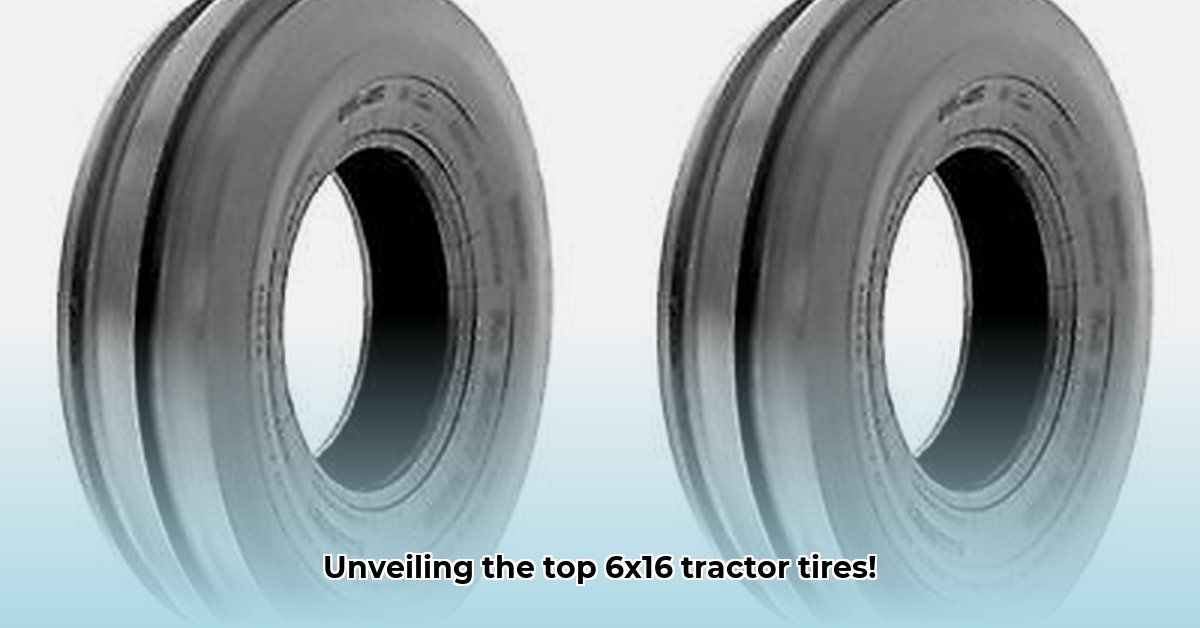
Finding the right 6x16 tractor tire involves more than just a high Easy Test Score. Today's farmers need tires that perform exceptionally while minimizing their environmental footprint. This article delves into the performance and sustainability aspects of 6x16 tractor tires, providing actionable steps for a greener future in agriculture. For more detailed information on specific tire sizes, check out this helpful resource: 6x16 Tractor Tires.
6 x 16 Tractor Tires: Performance and Sustainability
Choosing a 6x16 tractor tire requires balancing performance with environmental responsibility. While metrics like the Easy Test Score (a measure of tire traction) are valuable, they don't reflect the complete picture of sustainability. This means considering the tire's entire life cycle—from raw material sourcing to end-of-life disposal—to make truly informed decisions.
Understanding 6x16 Tractor Tire Performance Metrics
The Easy Test Score provides a useful initial assessment of traction. However, it's crucial to consider the tire's longevity. A tire with superior traction but a short lifespan might prove less efficient and more environmentally damaging over its lifetime compared to a tire with slightly lower traction but significantly longer lifespan. Factors such as rolling resistance (affecting fuel consumption) and overall wear significantly influence the tire's overall efficiency and environmental impact. Websites like Tires-Easy.com offer data on performance metrics, but a complete picture demands integrating these with broader lifecycle sustainability considerations.
The Environmental Footprint of 6x16 Tractor Tires: A Lifecycle Perspective
The environmental impact of a 6x16 tractor tire can be analyzed across its entire life cycle:
1. Material Sourcing: Conventional tire manufacturing relies heavily on petroleum-based materials like rubber and steel. The extraction and processing of these materials have significant environmental consequences. However, the agricultural sector is increasingly embracing bio-based rubber alternatives (derived from plants instead of petroleum) and increased utilization of recycled materials, offering a path toward more sustainable production.
2. Manufacturing Processes: Tire manufacturing is energy-intensive, contributing to greenhouse gas emissions. Adopting renewable energy sources in manufacturing facilities and optimizing manufacturing processes are key to reducing this environmental burden. Isn't it time we shifted our focus towards greener manufacturing practices?
3. Tire Lifespan: A tire's lifespan directly impacts its overall environmental footprint. Longer-lasting tires reduce the frequency of replacements, minimizing waste and resource consumption. Proper inflation and regular maintenance play a vital role in extending tire life and optimizing fuel efficiency. How can we ensure that our farm practices help maximize tire longevity?
4. End-of-Life Management: Disposal of worn-out tires is a significant sustainability challenge. Many end up in landfills, contributing to environmental pollution. Promoting responsible recycling methods, such as developing innovative processes to recover materials from used tires, is crucial. Investing in tire retreading is another valuable strategy for extending the life of these critical components and reducing waste.
5. Carbon Footprint & Life Cycle Assessment (LCA): A comprehensive Life Cycle Assessment (LCA) evaluates the environmental impact of a tire across its entire lifecycle, providing a holistic picture of its sustainability. Although complete LCA data for all 6x16 tires isn't always readily available, it's a crucial metric that's gaining traction in the industry; we eagerly anticipate more detailed LCAs for better informed choices.
Actionable Steps Towards Sustainable Tire Choices
Farmers, manufacturers, government agencies, and research institutions all have a role to play in promoting sustainability within the agriculture tire industry. Here’s how:
Farmers: Inquire about manufacturers’ sustainability initiatives when purchasing new tires. Advocate for better tire recycling programs and government incentives for sustainable options.
Tire Manufacturers: Increase transparency by providing clear information on the environmental impact of your tires. Invest in research and development of sustainable materials and manufacturing processes.
Government Agencies: Implement policies encouraging sustainable tire production and responsible disposal. Develop stricter environmental standards for the agricultural tire industry.
Research Institutions: Conduct comprehensive LCAs on various 6x16 tractor tire models. Support the development of innovative, environmentally friendly tire designs and materials.
Conclusion: A Sustainable Future for Agriculture
Choosing sustainable 6x16 tractor tires is a crucial step towards creating a more environmentally responsible agricultural sector. By prioritizing transparency, supporting eco-conscious companies, and advocating for effective policies, we can pave the way for a future where farming and environmental protection work in harmony. The choices we make today will directly impact the sustainability of agriculture for generations to come. Isn't it our responsibility to ensure a healthy planet for the future?
Further Resources
- Tires-Easy.com (replace with actual link if available)
- Example of a relevant agricultural research institution (replace with actual link)
- Example of a relevant government agency (replace with actual link)
(Note: Replace example links with actual links to relevant resources.)